Employee Wellness Programs: Analyzing Impact on Job Satisfaction
VerifiedAdded on 2021/05/10
|27
|6181
|129
Report
AI Summary
This report delves into the significance of employee wellness programs, exploring their impact on job satisfaction and overall workplace productivity. It begins with an introduction highlighting the importance of employee well-being for business success, referencing the quote by John Willard Marriott. The report identifies the problem of neglecting employee health and aims to demonstrate the positive correlation between wellness programs and employee satisfaction, loyalty, and job performance. Chapter 1 outlines the problem statement, research objectives, questions, and hypotheses, while Chapter 2 provides a comprehensive literature review, defining wellness, its dimensions (physical, emotional, occupational, intellectual, social, spiritual, and environmental), and various types of employee wellness programs, including fitness centers, yoga classes, paramedical services, smoking cessation programs, and nutrition programs. The report emphasizes the benefits of these programs for both employees and employers, such as increased productivity, reduced healthcare costs, and improved employee retention. The report highlights the importance of employee well-being for any organization.
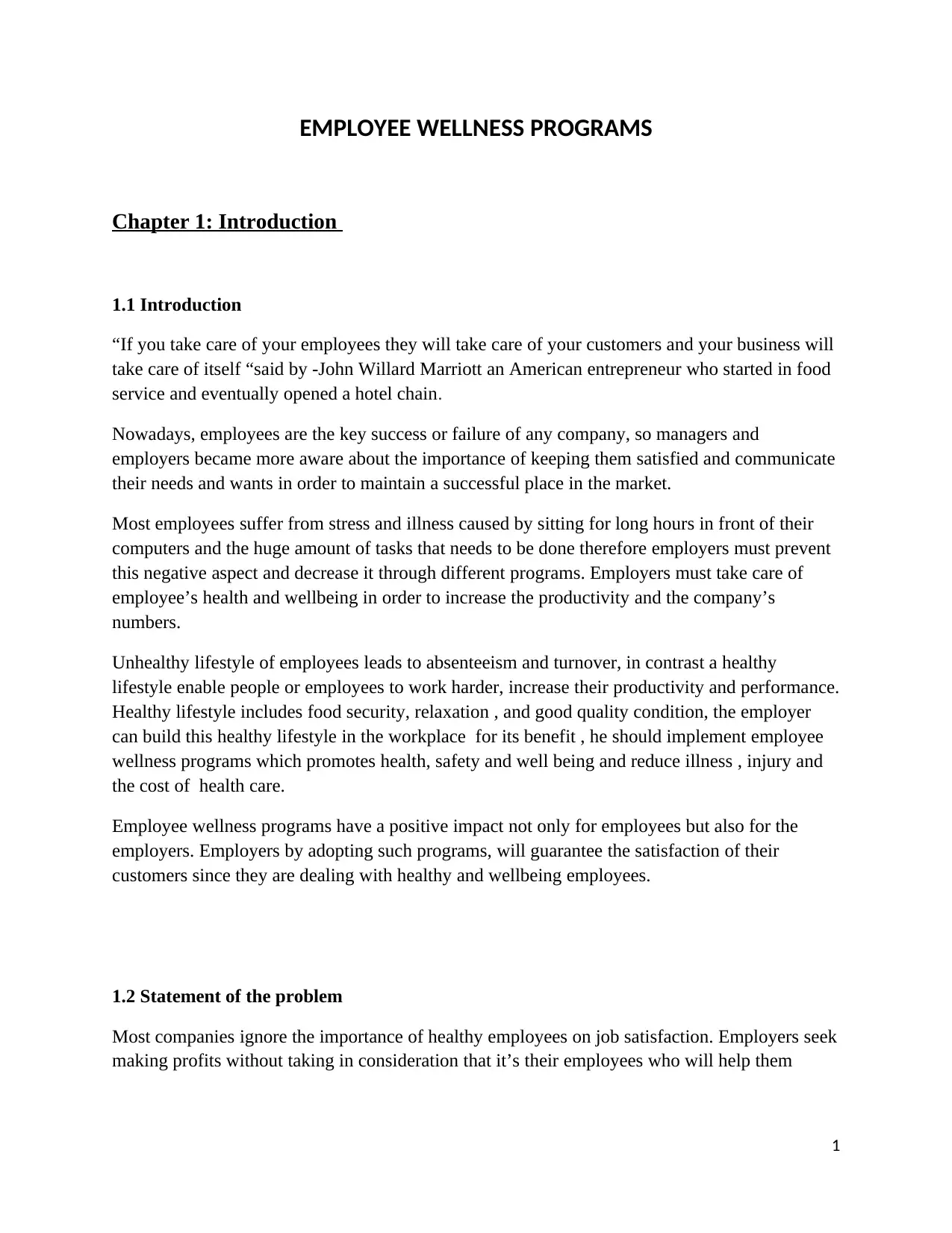
EMPLOYEE WELLNESS PROGRAMS
Chapter 1: Introduction
1.1 Introduction
“If you take care of your employees they will take care of your customers and your business will
take care of itself “said by -John Willard Marriott an American entrepreneur who started in food
service and eventually opened a hotel chain.
Nowadays, employees are the key success or failure of any company, so managers and
employers became more aware about the importance of keeping them satisfied and communicate
their needs and wants in order to maintain a successful place in the market.
Most employees suffer from stress and illness caused by sitting for long hours in front of their
computers and the huge amount of tasks that needs to be done therefore employers must prevent
this negative aspect and decrease it through different programs. Employers must take care of
employee’s health and wellbeing in order to increase the productivity and the company’s
numbers.
Unhealthy lifestyle of employees leads to absenteeism and turnover, in contrast a healthy
lifestyle enable people or employees to work harder, increase their productivity and performance.
Healthy lifestyle includes food security, relaxation , and good quality condition, the employer
can build this healthy lifestyle in the workplace for its benefit , he should implement employee
wellness programs which promotes health, safety and well being and reduce illness , injury and
the cost of health care.
Employee wellness programs have a positive impact not only for employees but also for the
employers. Employers by adopting such programs, will guarantee the satisfaction of their
customers since they are dealing with healthy and wellbeing employees.
1.2 Statement of the problem
Most companies ignore the importance of healthy employees on job satisfaction. Employers seek
making profits without taking in consideration that it’s their employees who will help them
1
Chapter 1: Introduction
1.1 Introduction
“If you take care of your employees they will take care of your customers and your business will
take care of itself “said by -John Willard Marriott an American entrepreneur who started in food
service and eventually opened a hotel chain.
Nowadays, employees are the key success or failure of any company, so managers and
employers became more aware about the importance of keeping them satisfied and communicate
their needs and wants in order to maintain a successful place in the market.
Most employees suffer from stress and illness caused by sitting for long hours in front of their
computers and the huge amount of tasks that needs to be done therefore employers must prevent
this negative aspect and decrease it through different programs. Employers must take care of
employee’s health and wellbeing in order to increase the productivity and the company’s
numbers.
Unhealthy lifestyle of employees leads to absenteeism and turnover, in contrast a healthy
lifestyle enable people or employees to work harder, increase their productivity and performance.
Healthy lifestyle includes food security, relaxation , and good quality condition, the employer
can build this healthy lifestyle in the workplace for its benefit , he should implement employee
wellness programs which promotes health, safety and well being and reduce illness , injury and
the cost of health care.
Employee wellness programs have a positive impact not only for employees but also for the
employers. Employers by adopting such programs, will guarantee the satisfaction of their
customers since they are dealing with healthy and wellbeing employees.
1.2 Statement of the problem
Most companies ignore the importance of healthy employees on job satisfaction. Employers seek
making profits without taking in consideration that it’s their employees who will help them
1
Paraphrase This Document
Need a fresh take? Get an instant paraphrase of this document with our AI Paraphraser
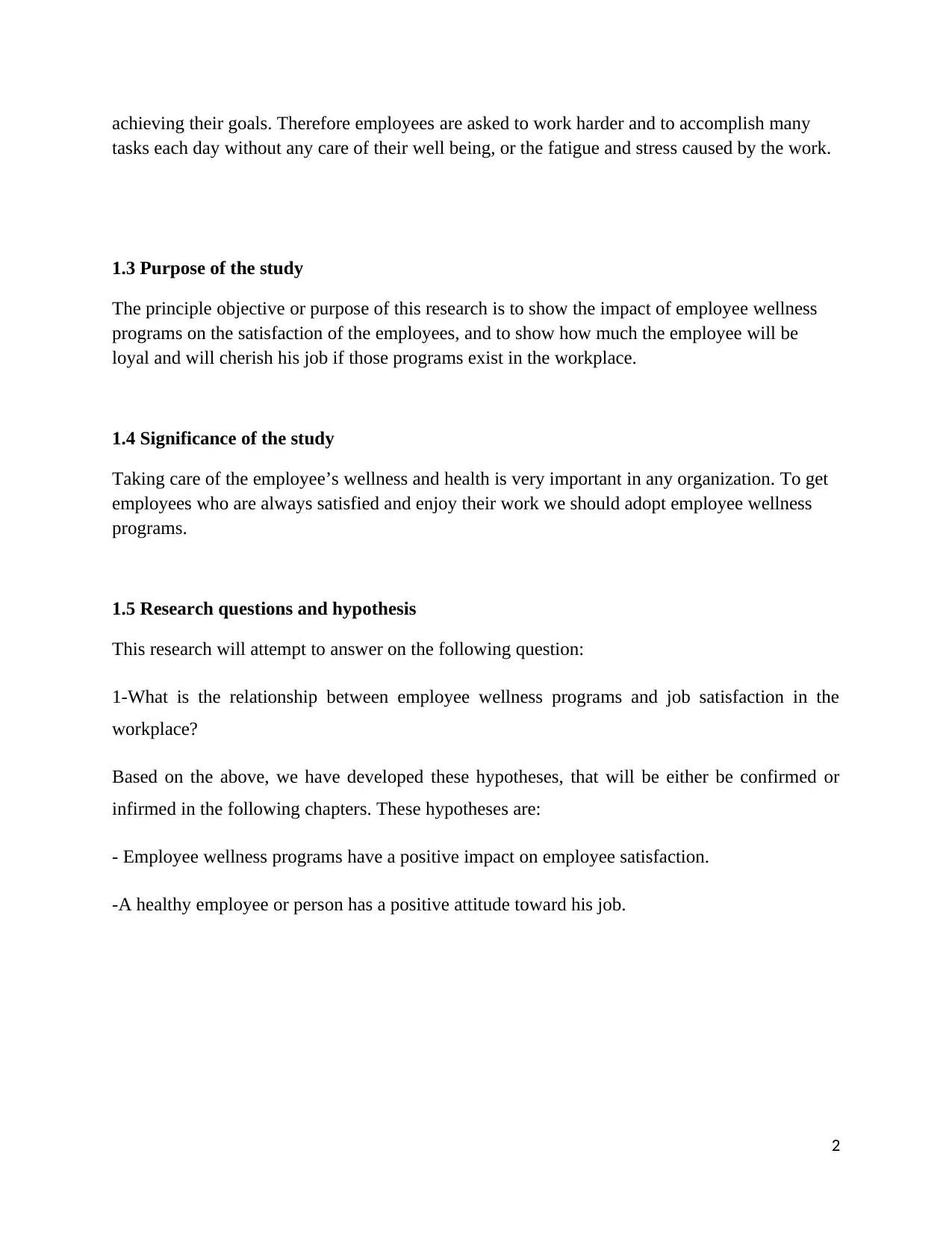
achieving their goals. Therefore employees are asked to work harder and to accomplish many
tasks each day without any care of their well being, or the fatigue and stress caused by the work.
1.3 Purpose of the study
The principle objective or purpose of this research is to show the impact of employee wellness
programs on the satisfaction of the employees, and to show how much the employee will be
loyal and will cherish his job if those programs exist in the workplace.
1.4 Significance of the study
Taking care of the employee’s wellness and health is very important in any organization. To get
employees who are always satisfied and enjoy their work we should adopt employee wellness
programs.
1.5 Research questions and hypothesis
This research will attempt to answer on the following question:
1-What is the relationship between employee wellness programs and job satisfaction in the
workplace?
Based on the above, we have developed these hypotheses, that will be either be confirmed or
infirmed in the following chapters. These hypotheses are:
- Employee wellness programs have a positive impact on employee satisfaction.
-A healthy employee or person has a positive attitude toward his job.
2
tasks each day without any care of their well being, or the fatigue and stress caused by the work.
1.3 Purpose of the study
The principle objective or purpose of this research is to show the impact of employee wellness
programs on the satisfaction of the employees, and to show how much the employee will be
loyal and will cherish his job if those programs exist in the workplace.
1.4 Significance of the study
Taking care of the employee’s wellness and health is very important in any organization. To get
employees who are always satisfied and enjoy their work we should adopt employee wellness
programs.
1.5 Research questions and hypothesis
This research will attempt to answer on the following question:
1-What is the relationship between employee wellness programs and job satisfaction in the
workplace?
Based on the above, we have developed these hypotheses, that will be either be confirmed or
infirmed in the following chapters. These hypotheses are:
- Employee wellness programs have a positive impact on employee satisfaction.
-A healthy employee or person has a positive attitude toward his job.
2
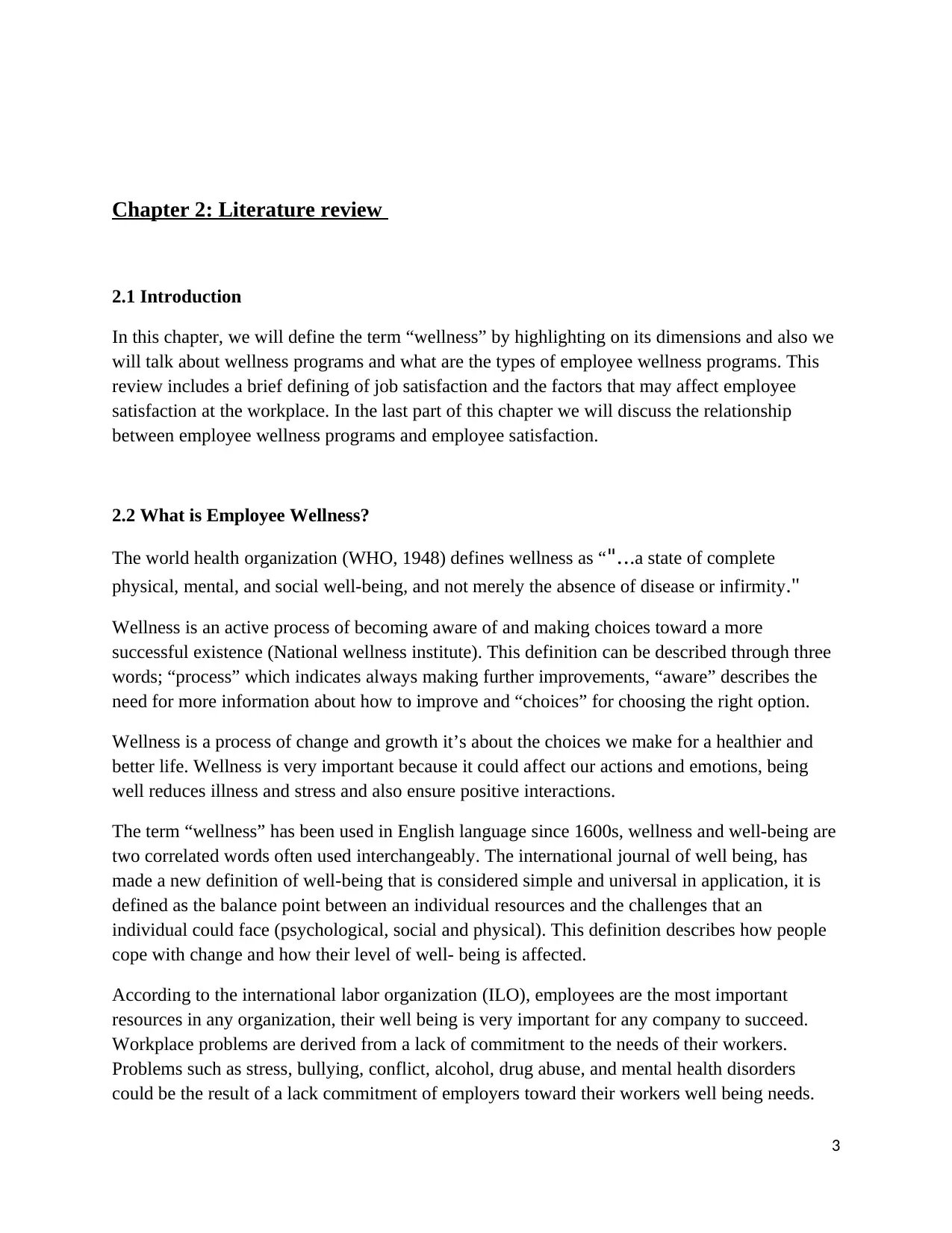
Chapter 2: Literature review
2.1 Introduction
In this chapter, we will define the term “wellness” by highlighting on its dimensions and also we
will talk about wellness programs and what are the types of employee wellness programs. This
review includes a brief defining of job satisfaction and the factors that may affect employee
satisfaction at the workplace. In the last part of this chapter we will discuss the relationship
between employee wellness programs and employee satisfaction.
2.2 What is Employee Wellness?
The world health organization (WHO, 1948) defines wellness as “"...a state of complete
physical, mental, and social well-being, and not merely the absence of disease or infirmity."
Wellness is an active process of becoming aware of and making choices toward a more
successful existence (National wellness institute). This definition can be described through three
words; “process” which indicates always making further improvements, “aware” describes the
need for more information about how to improve and “choices” for choosing the right option.
Wellness is a process of change and growth it’s about the choices we make for a healthier and
better life. Wellness is very important because it could affect our actions and emotions, being
well reduces illness and stress and also ensure positive interactions.
The term “wellness” has been used in English language since 1600s, wellness and well-being are
two correlated words often used interchangeably. The international journal of well being, has
made a new definition of well-being that is considered simple and universal in application, it is
defined as the balance point between an individual resources and the challenges that an
individual could face (psychological, social and physical). This definition describes how people
cope with change and how their level of well- being is affected.
According to the international labor organization (ILO), employees are the most important
resources in any organization, their well being is very important for any company to succeed.
Workplace problems are derived from a lack of commitment to the needs of their workers.
Problems such as stress, bullying, conflict, alcohol, drug abuse, and mental health disorders
could be the result of a lack commitment of employers toward their workers well being needs.
3
2.1 Introduction
In this chapter, we will define the term “wellness” by highlighting on its dimensions and also we
will talk about wellness programs and what are the types of employee wellness programs. This
review includes a brief defining of job satisfaction and the factors that may affect employee
satisfaction at the workplace. In the last part of this chapter we will discuss the relationship
between employee wellness programs and employee satisfaction.
2.2 What is Employee Wellness?
The world health organization (WHO, 1948) defines wellness as “"...a state of complete
physical, mental, and social well-being, and not merely the absence of disease or infirmity."
Wellness is an active process of becoming aware of and making choices toward a more
successful existence (National wellness institute). This definition can be described through three
words; “process” which indicates always making further improvements, “aware” describes the
need for more information about how to improve and “choices” for choosing the right option.
Wellness is a process of change and growth it’s about the choices we make for a healthier and
better life. Wellness is very important because it could affect our actions and emotions, being
well reduces illness and stress and also ensure positive interactions.
The term “wellness” has been used in English language since 1600s, wellness and well-being are
two correlated words often used interchangeably. The international journal of well being, has
made a new definition of well-being that is considered simple and universal in application, it is
defined as the balance point between an individual resources and the challenges that an
individual could face (psychological, social and physical). This definition describes how people
cope with change and how their level of well- being is affected.
According to the international labor organization (ILO), employees are the most important
resources in any organization, their well being is very important for any company to succeed.
Workplace problems are derived from a lack of commitment to the needs of their workers.
Problems such as stress, bullying, conflict, alcohol, drug abuse, and mental health disorders
could be the result of a lack commitment of employers toward their workers well being needs.
3
⊘ This is a preview!⊘
Do you want full access?
Subscribe today to unlock all pages.

Trusted by 1+ million students worldwide
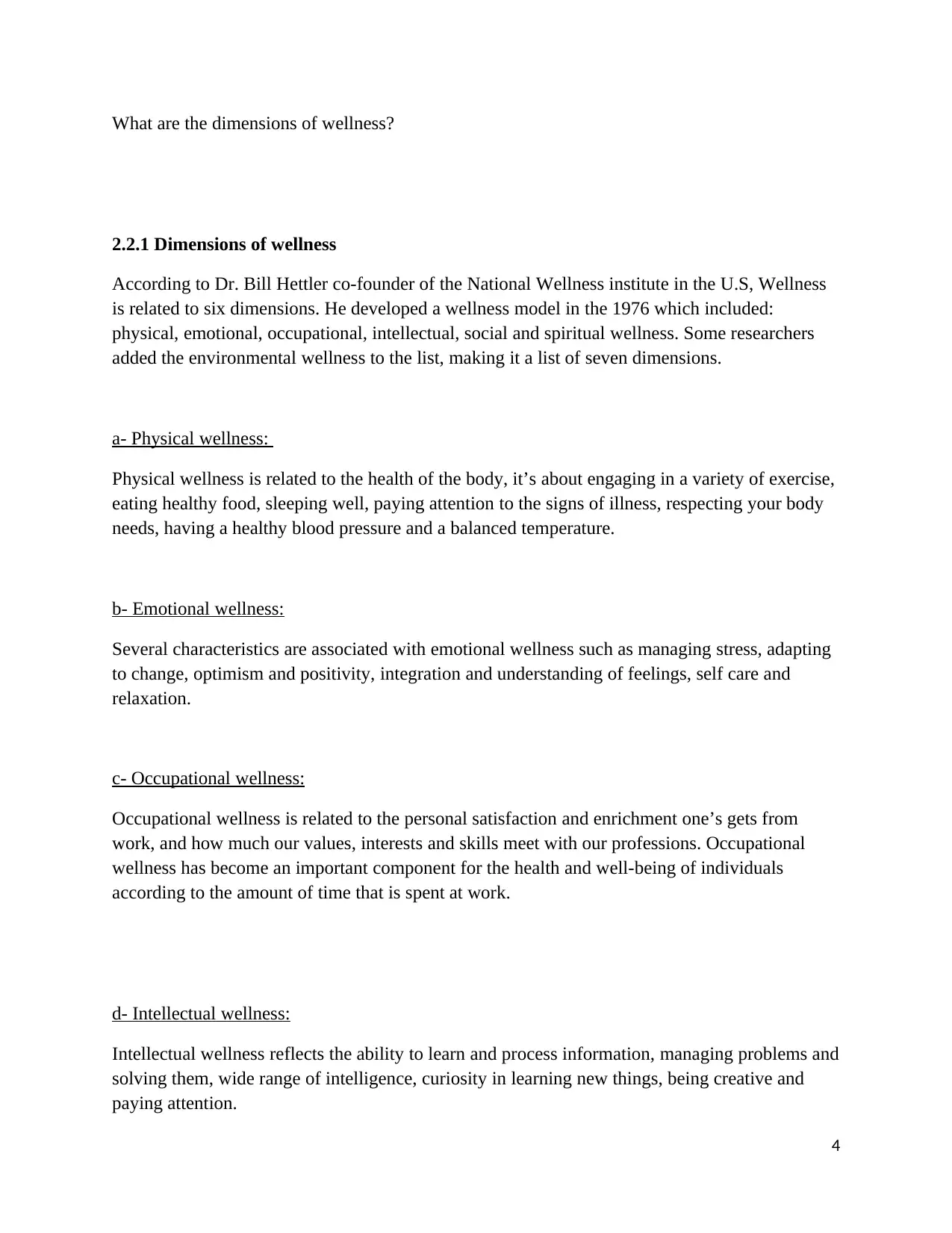
What are the dimensions of wellness?
2.2.1 Dimensions of wellness
According to Dr. Bill Hettler co-founder of the National Wellness institute in the U.S, Wellness
is related to six dimensions. He developed a wellness model in the 1976 which included:
physical, emotional, occupational, intellectual, social and spiritual wellness. Some researchers
added the environmental wellness to the list, making it a list of seven dimensions.
a- Physical wellness:
Physical wellness is related to the health of the body, it’s about engaging in a variety of exercise,
eating healthy food, sleeping well, paying attention to the signs of illness, respecting your body
needs, having a healthy blood pressure and a balanced temperature.
b- Emotional wellness:
Several characteristics are associated with emotional wellness such as managing stress, adapting
to change, optimism and positivity, integration and understanding of feelings, self care and
relaxation.
c- Occupational wellness:
Occupational wellness is related to the personal satisfaction and enrichment one’s gets from
work, and how much our values, interests and skills meet with our professions. Occupational
wellness has become an important component for the health and well-being of individuals
according to the amount of time that is spent at work.
d- Intellectual wellness:
Intellectual wellness reflects the ability to learn and process information, managing problems and
solving them, wide range of intelligence, curiosity in learning new things, being creative and
paying attention.
4
2.2.1 Dimensions of wellness
According to Dr. Bill Hettler co-founder of the National Wellness institute in the U.S, Wellness
is related to six dimensions. He developed a wellness model in the 1976 which included:
physical, emotional, occupational, intellectual, social and spiritual wellness. Some researchers
added the environmental wellness to the list, making it a list of seven dimensions.
a- Physical wellness:
Physical wellness is related to the health of the body, it’s about engaging in a variety of exercise,
eating healthy food, sleeping well, paying attention to the signs of illness, respecting your body
needs, having a healthy blood pressure and a balanced temperature.
b- Emotional wellness:
Several characteristics are associated with emotional wellness such as managing stress, adapting
to change, optimism and positivity, integration and understanding of feelings, self care and
relaxation.
c- Occupational wellness:
Occupational wellness is related to the personal satisfaction and enrichment one’s gets from
work, and how much our values, interests and skills meet with our professions. Occupational
wellness has become an important component for the health and well-being of individuals
according to the amount of time that is spent at work.
d- Intellectual wellness:
Intellectual wellness reflects the ability to learn and process information, managing problems and
solving them, wide range of intelligence, curiosity in learning new things, being creative and
paying attention.
4
Paraphrase This Document
Need a fresh take? Get an instant paraphrase of this document with our AI Paraphraser
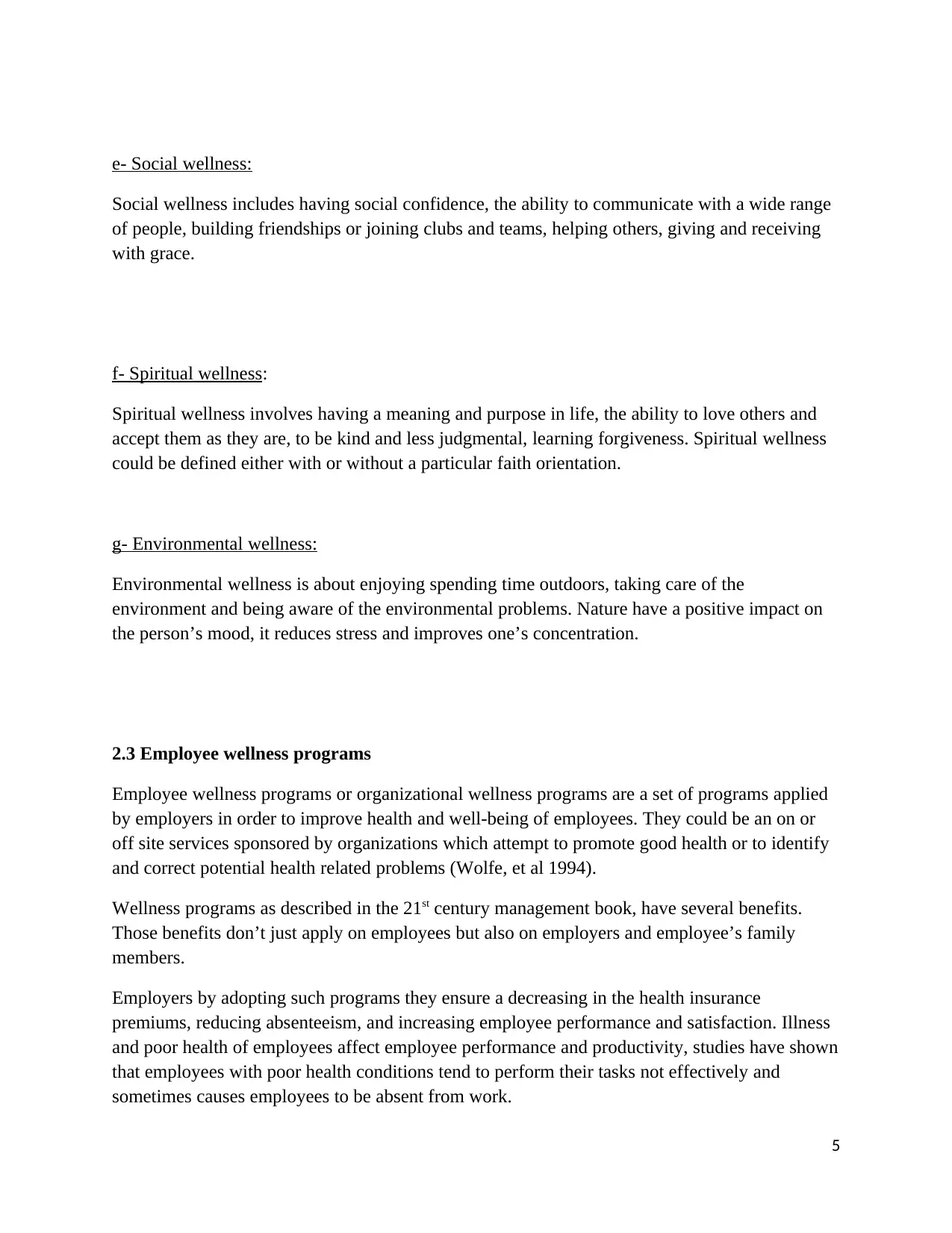
e- Social wellness:
Social wellness includes having social confidence, the ability to communicate with a wide range
of people, building friendships or joining clubs and teams, helping others, giving and receiving
with grace.
f- Spiritual wellness:
Spiritual wellness involves having a meaning and purpose in life, the ability to love others and
accept them as they are, to be kind and less judgmental, learning forgiveness. Spiritual wellness
could be defined either with or without a particular faith orientation.
g- Environmental wellness:
Environmental wellness is about enjoying spending time outdoors, taking care of the
environment and being aware of the environmental problems. Nature have a positive impact on
the person’s mood, it reduces stress and improves one’s concentration.
2.3 Employee wellness programs
Employee wellness programs or organizational wellness programs are a set of programs applied
by employers in order to improve health and well-being of employees. They could be an on or
off site services sponsored by organizations which attempt to promote good health or to identify
and correct potential health related problems (Wolfe, et al 1994).
Wellness programs as described in the 21st century management book, have several benefits.
Those benefits don’t just apply on employees but also on employers and employee’s family
members.
Employers by adopting such programs they ensure a decreasing in the health insurance
premiums, reducing absenteeism, and increasing employee performance and satisfaction. Illness
and poor health of employees affect employee performance and productivity, studies have shown
that employees with poor health conditions tend to perform their tasks not effectively and
sometimes causes employees to be absent from work.
5
Social wellness includes having social confidence, the ability to communicate with a wide range
of people, building friendships or joining clubs and teams, helping others, giving and receiving
with grace.
f- Spiritual wellness:
Spiritual wellness involves having a meaning and purpose in life, the ability to love others and
accept them as they are, to be kind and less judgmental, learning forgiveness. Spiritual wellness
could be defined either with or without a particular faith orientation.
g- Environmental wellness:
Environmental wellness is about enjoying spending time outdoors, taking care of the
environment and being aware of the environmental problems. Nature have a positive impact on
the person’s mood, it reduces stress and improves one’s concentration.
2.3 Employee wellness programs
Employee wellness programs or organizational wellness programs are a set of programs applied
by employers in order to improve health and well-being of employees. They could be an on or
off site services sponsored by organizations which attempt to promote good health or to identify
and correct potential health related problems (Wolfe, et al 1994).
Wellness programs as described in the 21st century management book, have several benefits.
Those benefits don’t just apply on employees but also on employers and employee’s family
members.
Employers by adopting such programs they ensure a decreasing in the health insurance
premiums, reducing absenteeism, and increasing employee performance and satisfaction. Illness
and poor health of employees affect employee performance and productivity, studies have shown
that employees with poor health conditions tend to perform their tasks not effectively and
sometimes causes employees to be absent from work.
5
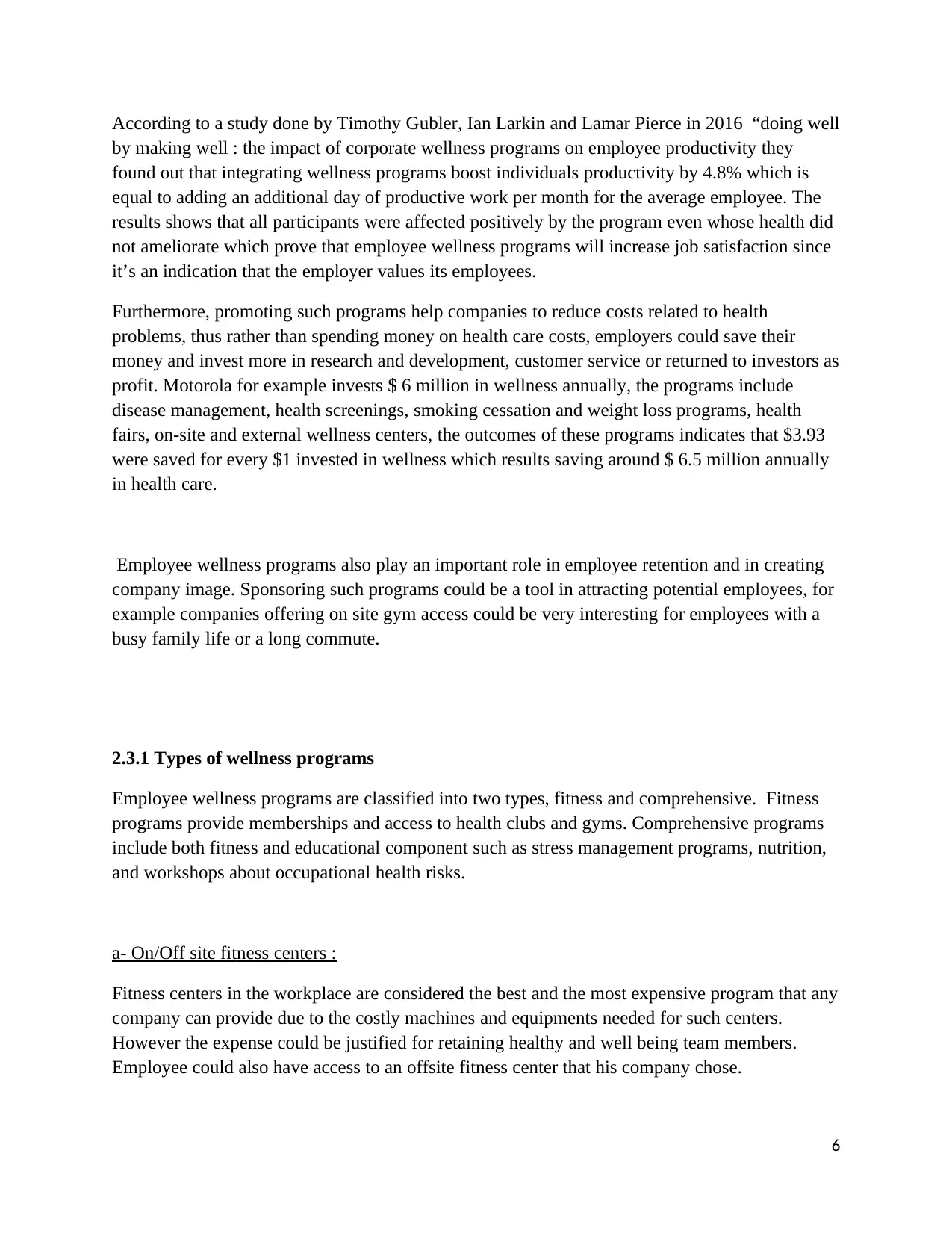
According to a study done by Timothy Gubler, Ian Larkin and Lamar Pierce in 2016 “doing well
by making well : the impact of corporate wellness programs on employee productivity they
found out that integrating wellness programs boost individuals productivity by 4.8% which is
equal to adding an additional day of productive work per month for the average employee. The
results shows that all participants were affected positively by the program even whose health did
not ameliorate which prove that employee wellness programs will increase job satisfaction since
it’s an indication that the employer values its employees.
Furthermore, promoting such programs help companies to reduce costs related to health
problems, thus rather than spending money on health care costs, employers could save their
money and invest more in research and development, customer service or returned to investors as
profit. Motorola for example invests $ 6 million in wellness annually, the programs include
disease management, health screenings, smoking cessation and weight loss programs, health
fairs, on-site and external wellness centers, the outcomes of these programs indicates that $3.93
were saved for every $1 invested in wellness which results saving around $ 6.5 million annually
in health care.
Employee wellness programs also play an important role in employee retention and in creating
company image. Sponsoring such programs could be a tool in attracting potential employees, for
example companies offering on site gym access could be very interesting for employees with a
busy family life or a long commute.
2.3.1 Types of wellness programs
Employee wellness programs are classified into two types, fitness and comprehensive. Fitness
programs provide memberships and access to health clubs and gyms. Comprehensive programs
include both fitness and educational component such as stress management programs, nutrition,
and workshops about occupational health risks.
a- On/Off site fitness centers :
Fitness centers in the workplace are considered the best and the most expensive program that any
company can provide due to the costly machines and equipments needed for such centers.
However the expense could be justified for retaining healthy and well being team members.
Employee could also have access to an offsite fitness center that his company chose.
6
by making well : the impact of corporate wellness programs on employee productivity they
found out that integrating wellness programs boost individuals productivity by 4.8% which is
equal to adding an additional day of productive work per month for the average employee. The
results shows that all participants were affected positively by the program even whose health did
not ameliorate which prove that employee wellness programs will increase job satisfaction since
it’s an indication that the employer values its employees.
Furthermore, promoting such programs help companies to reduce costs related to health
problems, thus rather than spending money on health care costs, employers could save their
money and invest more in research and development, customer service or returned to investors as
profit. Motorola for example invests $ 6 million in wellness annually, the programs include
disease management, health screenings, smoking cessation and weight loss programs, health
fairs, on-site and external wellness centers, the outcomes of these programs indicates that $3.93
were saved for every $1 invested in wellness which results saving around $ 6.5 million annually
in health care.
Employee wellness programs also play an important role in employee retention and in creating
company image. Sponsoring such programs could be a tool in attracting potential employees, for
example companies offering on site gym access could be very interesting for employees with a
busy family life or a long commute.
2.3.1 Types of wellness programs
Employee wellness programs are classified into two types, fitness and comprehensive. Fitness
programs provide memberships and access to health clubs and gyms. Comprehensive programs
include both fitness and educational component such as stress management programs, nutrition,
and workshops about occupational health risks.
a- On/Off site fitness centers :
Fitness centers in the workplace are considered the best and the most expensive program that any
company can provide due to the costly machines and equipments needed for such centers.
However the expense could be justified for retaining healthy and well being team members.
Employee could also have access to an offsite fitness center that his company chose.
6
⊘ This is a preview!⊘
Do you want full access?
Subscribe today to unlock all pages.

Trusted by 1+ million students worldwide
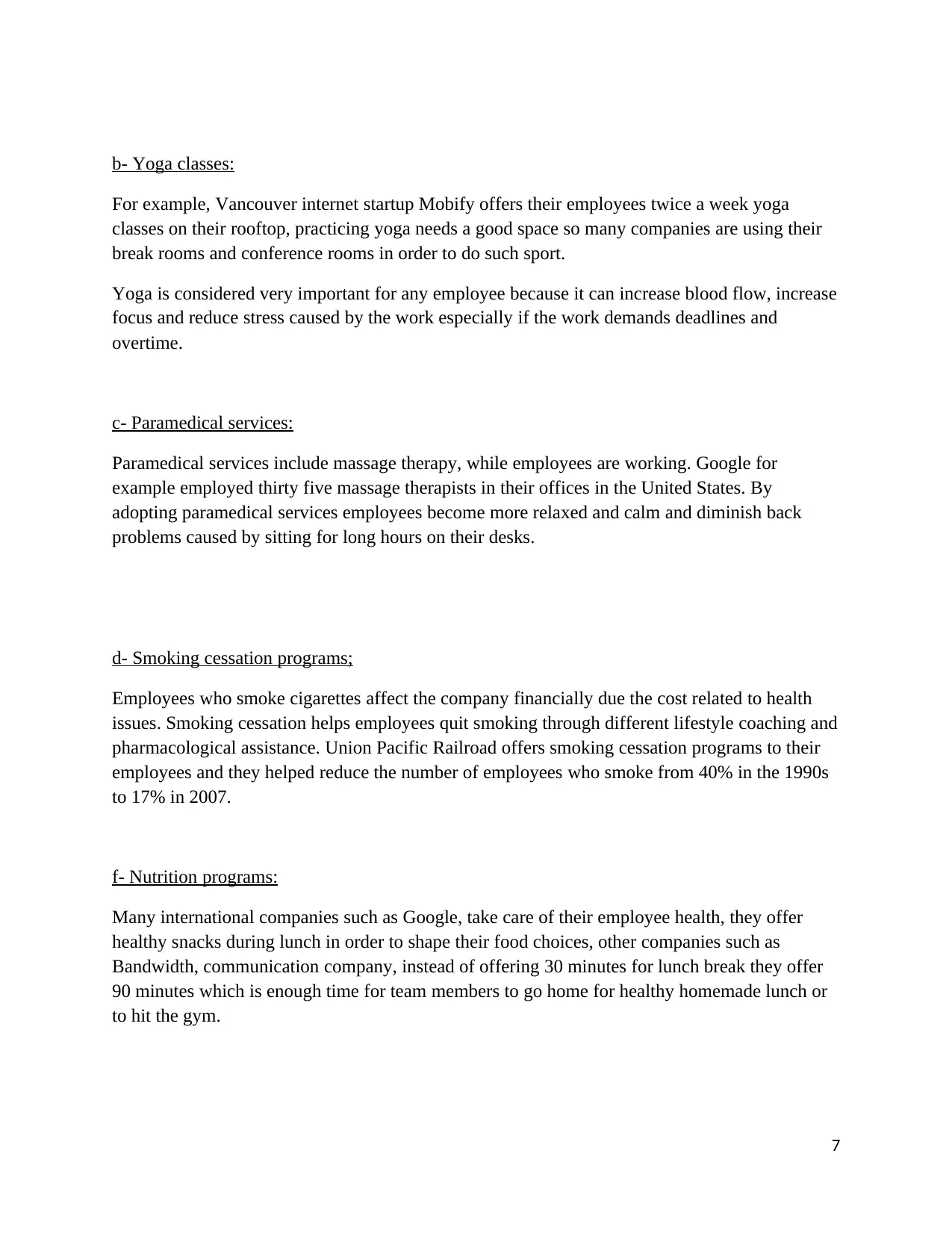
b- Yoga classes:
For example, Vancouver internet startup Mobify offers their employees twice a week yoga
classes on their rooftop, practicing yoga needs a good space so many companies are using their
break rooms and conference rooms in order to do such sport.
Yoga is considered very important for any employee because it can increase blood flow, increase
focus and reduce stress caused by the work especially if the work demands deadlines and
overtime.
c- Paramedical services:
Paramedical services include massage therapy, while employees are working. Google for
example employed thirty five massage therapists in their offices in the United States. By
adopting paramedical services employees become more relaxed and calm and diminish back
problems caused by sitting for long hours on their desks.
d- Smoking cessation programs;
Employees who smoke cigarettes affect the company financially due the cost related to health
issues. Smoking cessation helps employees quit smoking through different lifestyle coaching and
pharmacological assistance. Union Pacific Railroad offers smoking cessation programs to their
employees and they helped reduce the number of employees who smoke from 40% in the 1990s
to 17% in 2007.
f- Nutrition programs:
Many international companies such as Google, take care of their employee health, they offer
healthy snacks during lunch in order to shape their food choices, other companies such as
Bandwidth, communication company, instead of offering 30 minutes for lunch break they offer
90 minutes which is enough time for team members to go home for healthy homemade lunch or
to hit the gym.
7
For example, Vancouver internet startup Mobify offers their employees twice a week yoga
classes on their rooftop, practicing yoga needs a good space so many companies are using their
break rooms and conference rooms in order to do such sport.
Yoga is considered very important for any employee because it can increase blood flow, increase
focus and reduce stress caused by the work especially if the work demands deadlines and
overtime.
c- Paramedical services:
Paramedical services include massage therapy, while employees are working. Google for
example employed thirty five massage therapists in their offices in the United States. By
adopting paramedical services employees become more relaxed and calm and diminish back
problems caused by sitting for long hours on their desks.
d- Smoking cessation programs;
Employees who smoke cigarettes affect the company financially due the cost related to health
issues. Smoking cessation helps employees quit smoking through different lifestyle coaching and
pharmacological assistance. Union Pacific Railroad offers smoking cessation programs to their
employees and they helped reduce the number of employees who smoke from 40% in the 1990s
to 17% in 2007.
f- Nutrition programs:
Many international companies such as Google, take care of their employee health, they offer
healthy snacks during lunch in order to shape their food choices, other companies such as
Bandwidth, communication company, instead of offering 30 minutes for lunch break they offer
90 minutes which is enough time for team members to go home for healthy homemade lunch or
to hit the gym.
7
Paraphrase This Document
Need a fresh take? Get an instant paraphrase of this document with our AI Paraphraser
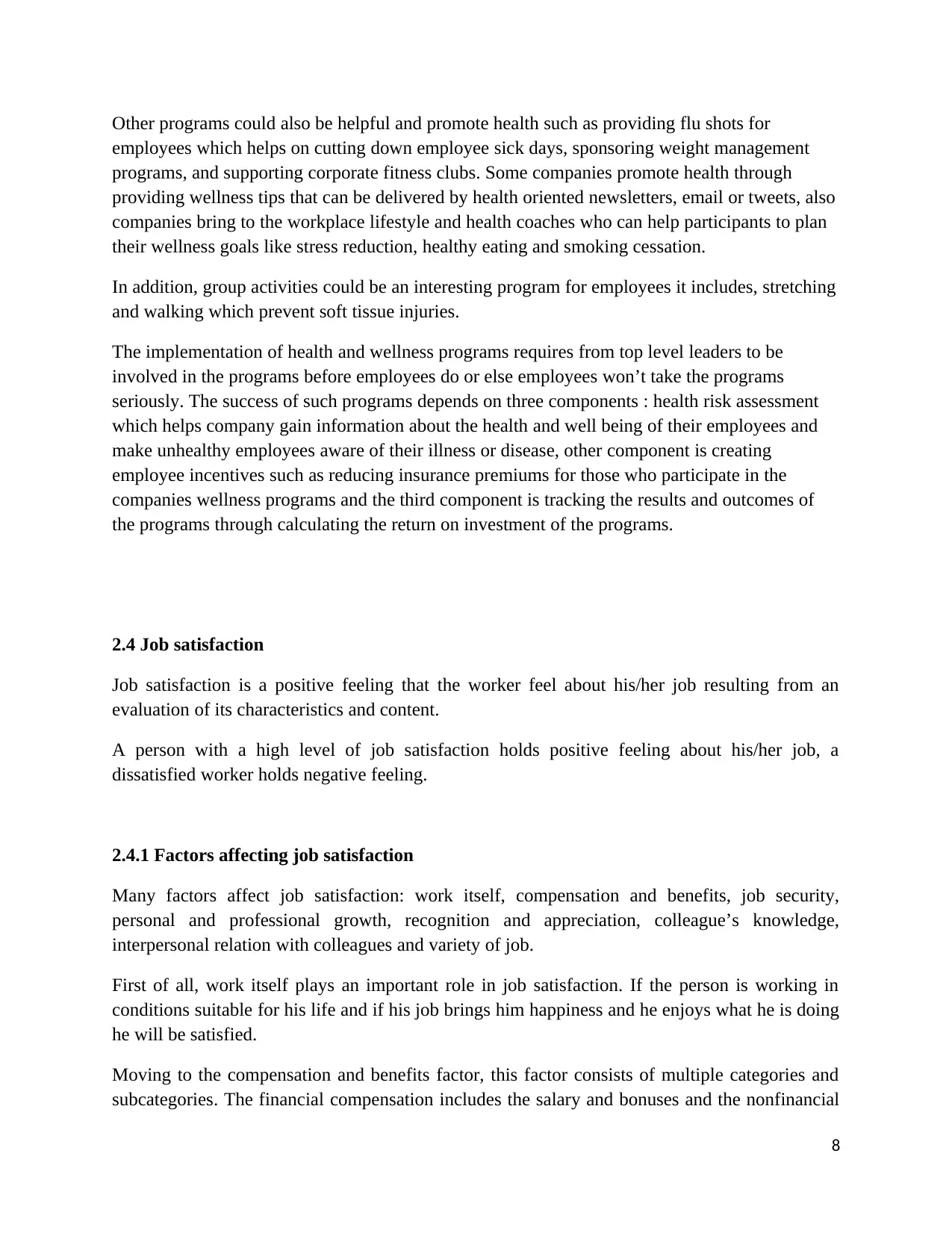
Other programs could also be helpful and promote health such as providing flu shots for
employees which helps on cutting down employee sick days, sponsoring weight management
programs, and supporting corporate fitness clubs. Some companies promote health through
providing wellness tips that can be delivered by health oriented newsletters, email or tweets, also
companies bring to the workplace lifestyle and health coaches who can help participants to plan
their wellness goals like stress reduction, healthy eating and smoking cessation.
In addition, group activities could be an interesting program for employees it includes, stretching
and walking which prevent soft tissue injuries.
The implementation of health and wellness programs requires from top level leaders to be
involved in the programs before employees do or else employees won’t take the programs
seriously. The success of such programs depends on three components : health risk assessment
which helps company gain information about the health and well being of their employees and
make unhealthy employees aware of their illness or disease, other component is creating
employee incentives such as reducing insurance premiums for those who participate in the
companies wellness programs and the third component is tracking the results and outcomes of
the programs through calculating the return on investment of the programs.
2.4 Job satisfaction
Job satisfaction is a positive feeling that the worker feel about his/her job resulting from an
evaluation of its characteristics and content.
A person with a high level of job satisfaction holds positive feeling about his/her job, a
dissatisfied worker holds negative feeling.
2.4.1 Factors affecting job satisfaction
Many factors affect job satisfaction: work itself, compensation and benefits, job security,
personal and professional growth, recognition and appreciation, colleague’s knowledge,
interpersonal relation with colleagues and variety of job.
First of all, work itself plays an important role in job satisfaction. If the person is working in
conditions suitable for his life and if his job brings him happiness and he enjoys what he is doing
he will be satisfied.
Moving to the compensation and benefits factor, this factor consists of multiple categories and
subcategories. The financial compensation includes the salary and bonuses and the nonfinancial
8
employees which helps on cutting down employee sick days, sponsoring weight management
programs, and supporting corporate fitness clubs. Some companies promote health through
providing wellness tips that can be delivered by health oriented newsletters, email or tweets, also
companies bring to the workplace lifestyle and health coaches who can help participants to plan
their wellness goals like stress reduction, healthy eating and smoking cessation.
In addition, group activities could be an interesting program for employees it includes, stretching
and walking which prevent soft tissue injuries.
The implementation of health and wellness programs requires from top level leaders to be
involved in the programs before employees do or else employees won’t take the programs
seriously. The success of such programs depends on three components : health risk assessment
which helps company gain information about the health and well being of their employees and
make unhealthy employees aware of their illness or disease, other component is creating
employee incentives such as reducing insurance premiums for those who participate in the
companies wellness programs and the third component is tracking the results and outcomes of
the programs through calculating the return on investment of the programs.
2.4 Job satisfaction
Job satisfaction is a positive feeling that the worker feel about his/her job resulting from an
evaluation of its characteristics and content.
A person with a high level of job satisfaction holds positive feeling about his/her job, a
dissatisfied worker holds negative feeling.
2.4.1 Factors affecting job satisfaction
Many factors affect job satisfaction: work itself, compensation and benefits, job security,
personal and professional growth, recognition and appreciation, colleague’s knowledge,
interpersonal relation with colleagues and variety of job.
First of all, work itself plays an important role in job satisfaction. If the person is working in
conditions suitable for his life and if his job brings him happiness and he enjoys what he is doing
he will be satisfied.
Moving to the compensation and benefits factor, this factor consists of multiple categories and
subcategories. The financial compensation includes the salary and bonuses and the nonfinancial
8
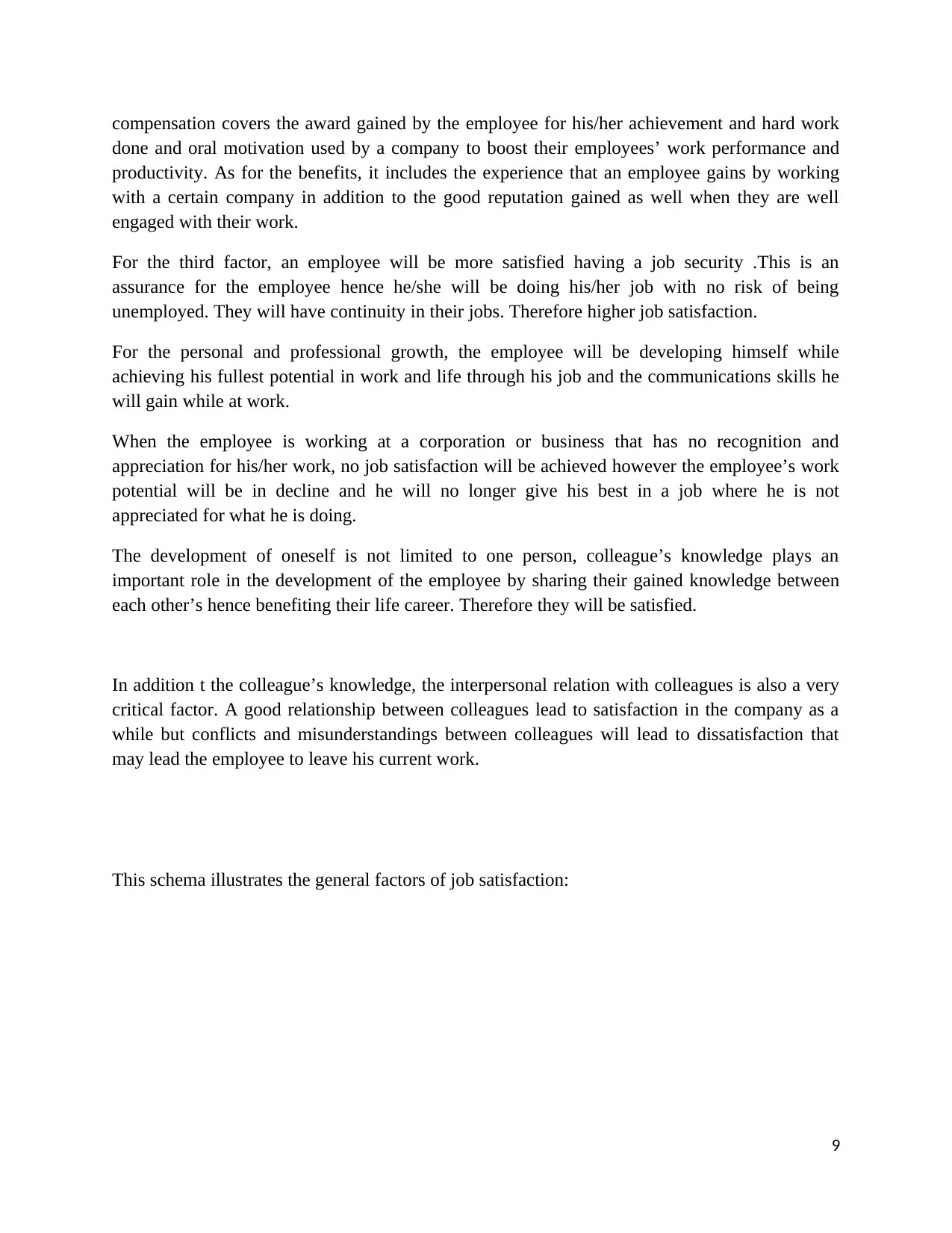
compensation covers the award gained by the employee for his/her achievement and hard work
done and oral motivation used by a company to boost their employees’ work performance and
productivity. As for the benefits, it includes the experience that an employee gains by working
with a certain company in addition to the good reputation gained as well when they are well
engaged with their work.
For the third factor, an employee will be more satisfied having a job security .This is an
assurance for the employee hence he/she will be doing his/her job with no risk of being
unemployed. They will have continuity in their jobs. Therefore higher job satisfaction.
For the personal and professional growth, the employee will be developing himself while
achieving his fullest potential in work and life through his job and the communications skills he
will gain while at work.
When the employee is working at a corporation or business that has no recognition and
appreciation for his/her work, no job satisfaction will be achieved however the employee’s work
potential will be in decline and he will no longer give his best in a job where he is not
appreciated for what he is doing.
The development of oneself is not limited to one person, colleague’s knowledge plays an
important role in the development of the employee by sharing their gained knowledge between
each other’s hence benefiting their life career. Therefore they will be satisfied.
In addition t the colleague’s knowledge, the interpersonal relation with colleagues is also a very
critical factor. A good relationship between colleagues lead to satisfaction in the company as a
while but conflicts and misunderstandings between colleagues will lead to dissatisfaction that
may lead the employee to leave his current work.
This schema illustrates the general factors of job satisfaction:
9
done and oral motivation used by a company to boost their employees’ work performance and
productivity. As for the benefits, it includes the experience that an employee gains by working
with a certain company in addition to the good reputation gained as well when they are well
engaged with their work.
For the third factor, an employee will be more satisfied having a job security .This is an
assurance for the employee hence he/she will be doing his/her job with no risk of being
unemployed. They will have continuity in their jobs. Therefore higher job satisfaction.
For the personal and professional growth, the employee will be developing himself while
achieving his fullest potential in work and life through his job and the communications skills he
will gain while at work.
When the employee is working at a corporation or business that has no recognition and
appreciation for his/her work, no job satisfaction will be achieved however the employee’s work
potential will be in decline and he will no longer give his best in a job where he is not
appreciated for what he is doing.
The development of oneself is not limited to one person, colleague’s knowledge plays an
important role in the development of the employee by sharing their gained knowledge between
each other’s hence benefiting their life career. Therefore they will be satisfied.
In addition t the colleague’s knowledge, the interpersonal relation with colleagues is also a very
critical factor. A good relationship between colleagues lead to satisfaction in the company as a
while but conflicts and misunderstandings between colleagues will lead to dissatisfaction that
may lead the employee to leave his current work.
This schema illustrates the general factors of job satisfaction:
9
⊘ This is a preview!⊘
Do you want full access?
Subscribe today to unlock all pages.

Trusted by 1+ million students worldwide
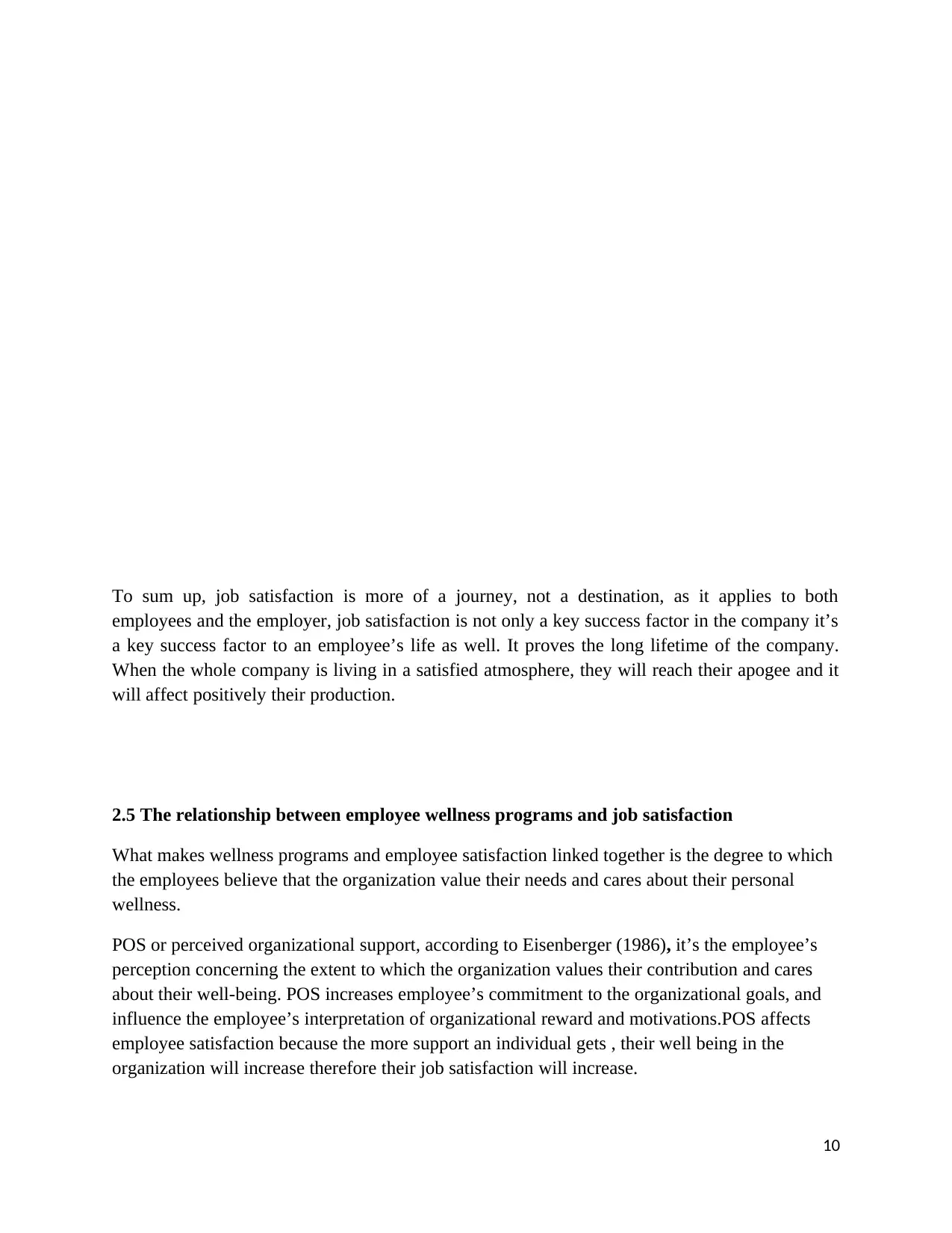
To sum up, job satisfaction is more of a journey, not a destination, as it applies to both
employees and the employer, job satisfaction is not only a key success factor in the company it’s
a key success factor to an employee’s life as well. It proves the long lifetime of the company.
When the whole company is living in a satisfied atmosphere, they will reach their apogee and it
will affect positively their production.
2.5 The relationship between employee wellness programs and job satisfaction
What makes wellness programs and employee satisfaction linked together is the degree to which
the employees believe that the organization value their needs and cares about their personal
wellness.
POS or perceived organizational support, according to Eisenberger (1986), it’s the employee’s
perception concerning the extent to which the organization values their contribution and cares
about their well-being. POS increases employee’s commitment to the organizational goals, and
influence the employee’s interpretation of organizational reward and motivations.POS affects
employee satisfaction because the more support an individual gets , their well being in the
organization will increase therefore their job satisfaction will increase.
10
Workitself-jobscope-variety-autonomyandfreedomPersonalfactors-ageandseniority-tenure-personality
employees and the employer, job satisfaction is not only a key success factor in the company it’s
a key success factor to an employee’s life as well. It proves the long lifetime of the company.
When the whole company is living in a satisfied atmosphere, they will reach their apogee and it
will affect positively their production.
2.5 The relationship between employee wellness programs and job satisfaction
What makes wellness programs and employee satisfaction linked together is the degree to which
the employees believe that the organization value their needs and cares about their personal
wellness.
POS or perceived organizational support, according to Eisenberger (1986), it’s the employee’s
perception concerning the extent to which the organization values their contribution and cares
about their well-being. POS increases employee’s commitment to the organizational goals, and
influence the employee’s interpretation of organizational reward and motivations.POS affects
employee satisfaction because the more support an individual gets , their well being in the
organization will increase therefore their job satisfaction will increase.
10
Workitself-jobscope-variety-autonomyandfreedomPersonalfactors-ageandseniority-tenure-personality
Paraphrase This Document
Need a fresh take? Get an instant paraphrase of this document with our AI Paraphraser
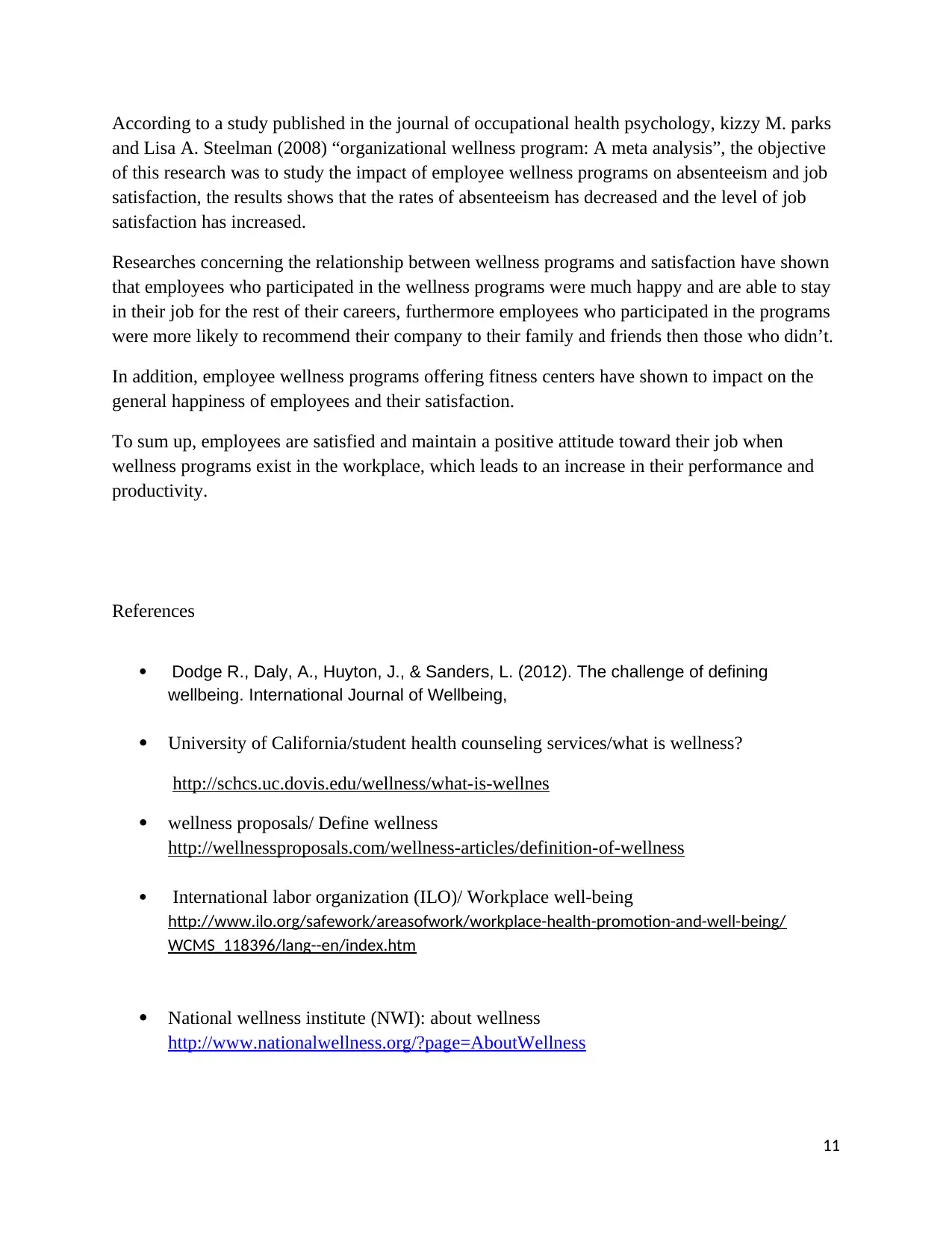
According to a study published in the journal of occupational health psychology, kizzy M. parks
and Lisa A. Steelman (2008) “organizational wellness program: A meta analysis”, the objective
of this research was to study the impact of employee wellness programs on absenteeism and job
satisfaction, the results shows that the rates of absenteeism has decreased and the level of job
satisfaction has increased.
Researches concerning the relationship between wellness programs and satisfaction have shown
that employees who participated in the wellness programs were much happy and are able to stay
in their job for the rest of their careers, furthermore employees who participated in the programs
were more likely to recommend their company to their family and friends then those who didn’t.
In addition, employee wellness programs offering fitness centers have shown to impact on the
general happiness of employees and their satisfaction.
To sum up, employees are satisfied and maintain a positive attitude toward their job when
wellness programs exist in the workplace, which leads to an increase in their performance and
productivity.
References
Dodge R., Daly, A., Huyton, J., & Sanders, L. (2012). The challenge of defining
wellbeing. International Journal of Wellbeing,
University of California/student health counseling services/what is wellness?
http://schcs.uc.dovis.edu/wellness/what-is-wellnes
wellness proposals/ Define wellness
http://wellnessproposals.com/wellness-articles/definition-of-wellness
International labor organization (ILO)/ Workplace well-being
http://www.ilo.org/safework/areasofwork/workplace-health-promotion-and-well-being/
WCMS_118396/lang--en/index.htm
National wellness institute (NWI): about wellness
http://www.nationalwellness.org/?page=AboutWellness
11
and Lisa A. Steelman (2008) “organizational wellness program: A meta analysis”, the objective
of this research was to study the impact of employee wellness programs on absenteeism and job
satisfaction, the results shows that the rates of absenteeism has decreased and the level of job
satisfaction has increased.
Researches concerning the relationship between wellness programs and satisfaction have shown
that employees who participated in the wellness programs were much happy and are able to stay
in their job for the rest of their careers, furthermore employees who participated in the programs
were more likely to recommend their company to their family and friends then those who didn’t.
In addition, employee wellness programs offering fitness centers have shown to impact on the
general happiness of employees and their satisfaction.
To sum up, employees are satisfied and maintain a positive attitude toward their job when
wellness programs exist in the workplace, which leads to an increase in their performance and
productivity.
References
Dodge R., Daly, A., Huyton, J., & Sanders, L. (2012). The challenge of defining
wellbeing. International Journal of Wellbeing,
University of California/student health counseling services/what is wellness?
http://schcs.uc.dovis.edu/wellness/what-is-wellnes
wellness proposals/ Define wellness
http://wellnessproposals.com/wellness-articles/definition-of-wellness
International labor organization (ILO)/ Workplace well-being
http://www.ilo.org/safework/areasofwork/workplace-health-promotion-and-well-being/
WCMS_118396/lang--en/index.htm
National wellness institute (NWI): about wellness
http://www.nationalwellness.org/?page=AboutWellness
11
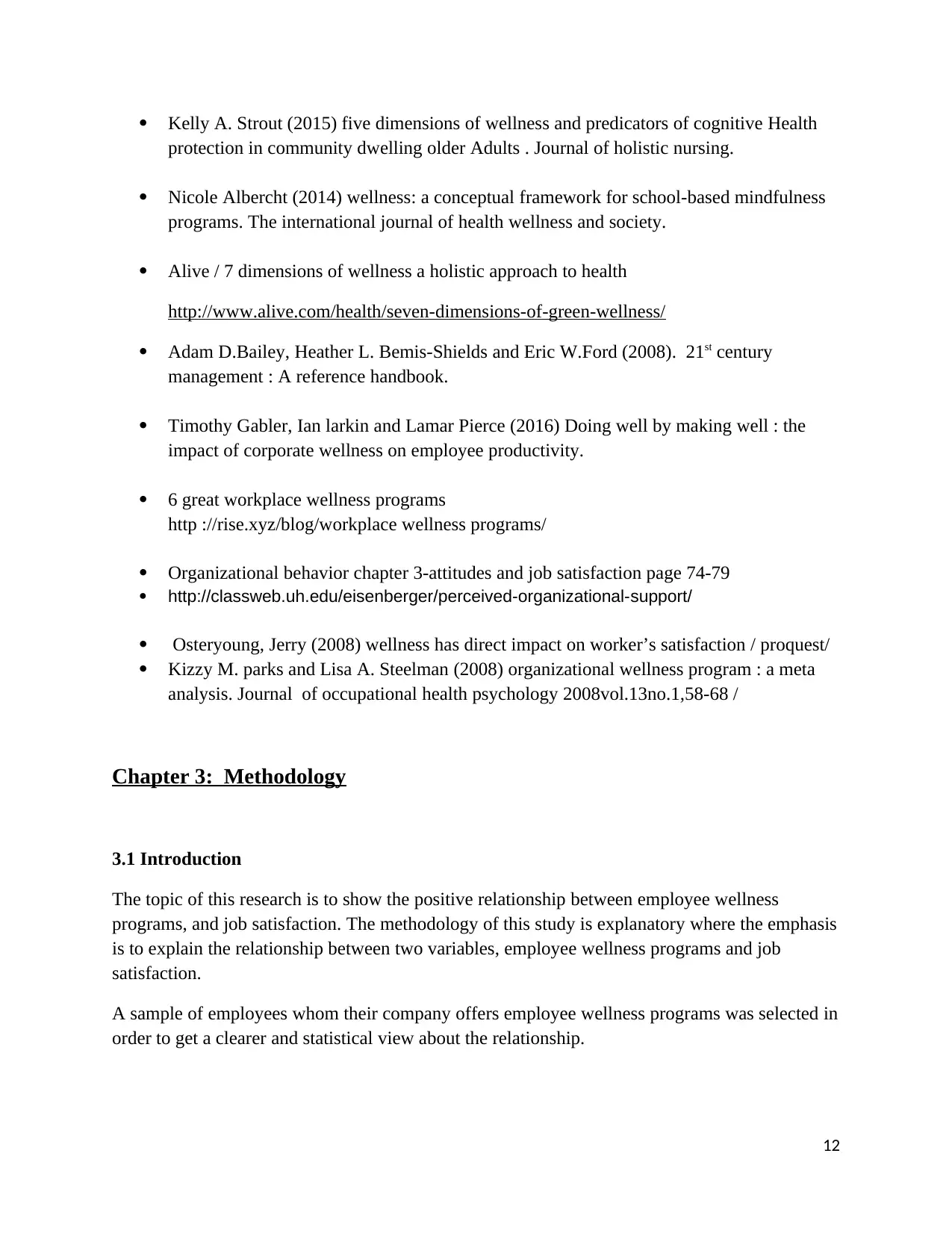
Kelly A. Strout (2015) five dimensions of wellness and predicators of cognitive Health
protection in community dwelling older Adults . Journal of holistic nursing.
Nicole Albercht (2014) wellness: a conceptual framework for school-based mindfulness
programs. The international journal of health wellness and society.
Alive / 7 dimensions of wellness a holistic approach to health
http://www.alive.com/health/seven-dimensions-of-green-wellness/
Adam D.Bailey, Heather L. Bemis-Shields and Eric W.Ford (2008). 21st century
management : A reference handbook.
Timothy Gabler, Ian larkin and Lamar Pierce (2016) Doing well by making well : the
impact of corporate wellness on employee productivity.
6 great workplace wellness programs
http ://rise.xyz/blog/workplace wellness programs/
Organizational behavior chapter 3-attitudes and job satisfaction page 74-79
http://classweb.uh.edu/eisenberger/perceived-organizational-support/
Osteryoung, Jerry (2008) wellness has direct impact on worker’s satisfaction / proquest/
Kizzy M. parks and Lisa A. Steelman (2008) organizational wellness program : a meta
analysis. Journal of occupational health psychology 2008vol.13no.1,58-68 /
Chapter 3: Methodology
3.1 Introduction
The topic of this research is to show the positive relationship between employee wellness
programs, and job satisfaction. The methodology of this study is explanatory where the emphasis
is to explain the relationship between two variables, employee wellness programs and job
satisfaction.
A sample of employees whom their company offers employee wellness programs was selected in
order to get a clearer and statistical view about the relationship.
12
protection in community dwelling older Adults . Journal of holistic nursing.
Nicole Albercht (2014) wellness: a conceptual framework for school-based mindfulness
programs. The international journal of health wellness and society.
Alive / 7 dimensions of wellness a holistic approach to health
http://www.alive.com/health/seven-dimensions-of-green-wellness/
Adam D.Bailey, Heather L. Bemis-Shields and Eric W.Ford (2008). 21st century
management : A reference handbook.
Timothy Gabler, Ian larkin and Lamar Pierce (2016) Doing well by making well : the
impact of corporate wellness on employee productivity.
6 great workplace wellness programs
http ://rise.xyz/blog/workplace wellness programs/
Organizational behavior chapter 3-attitudes and job satisfaction page 74-79
http://classweb.uh.edu/eisenberger/perceived-organizational-support/
Osteryoung, Jerry (2008) wellness has direct impact on worker’s satisfaction / proquest/
Kizzy M. parks and Lisa A. Steelman (2008) organizational wellness program : a meta
analysis. Journal of occupational health psychology 2008vol.13no.1,58-68 /
Chapter 3: Methodology
3.1 Introduction
The topic of this research is to show the positive relationship between employee wellness
programs, and job satisfaction. The methodology of this study is explanatory where the emphasis
is to explain the relationship between two variables, employee wellness programs and job
satisfaction.
A sample of employees whom their company offers employee wellness programs was selected in
order to get a clearer and statistical view about the relationship.
12
⊘ This is a preview!⊘
Do you want full access?
Subscribe today to unlock all pages.

Trusted by 1+ million students worldwide
1 out of 27
Related Documents
Your All-in-One AI-Powered Toolkit for Academic Success.
+13062052269
info@desklib.com
Available 24*7 on WhatsApp / Email
![[object Object]](/_next/static/media/star-bottom.7253800d.svg)
Unlock your academic potential
Copyright © 2020–2025 A2Z Services. All Rights Reserved. Developed and managed by ZUCOL.





